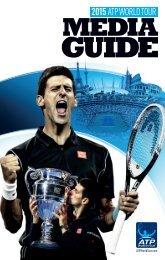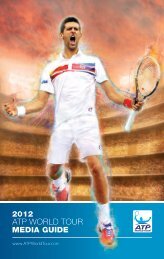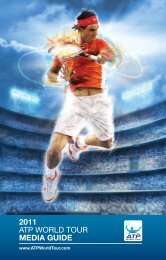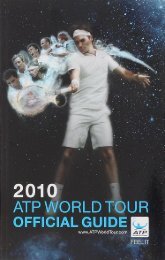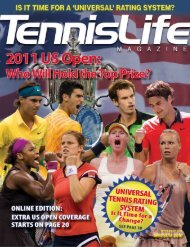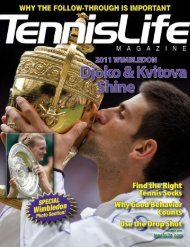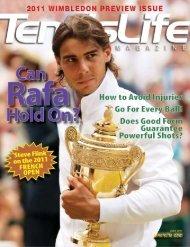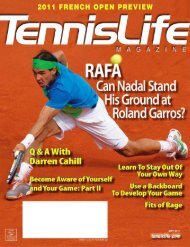The tennis drill book-2e
www.tennismoscow.me Insta:TENNISMOSCOW
www.tennismoscow.me Insta:TENNISMOSCOW
- No tags were found...
You also want an ePaper? Increase the reach of your titles
YUMPU automatically turns print PDFs into web optimized ePapers that Google loves.
12 <strong>The</strong> Tennis Drill Book<br />
When practicing groundstrokes, every player’s primary objective is to work<br />
on better accuracy, control, and power. Sound groundstroking begins with<br />
the player’s approach to an incoming ball. Players can use either a forehand<br />
or a backhand to hit groundstrokes from baseline to baseline or service line to<br />
service line inside of the mini-court area. Every part of the body is involved<br />
in returning a <strong>tennis</strong> ball successfully. For example, if players attempt to hit<br />
a shot crosscourt but the ball flies up and over the fence, their first thought<br />
may be that they are hitting the ball too hard or just don't have the finesse<br />
it takes to control the ball. <strong>The</strong> problem isn't too much strength or lack of<br />
finesse, it's the approach to the ball and what happens when players actually<br />
strike the ball. If players lift the chin or head while striking the ball, the ball<br />
will follow the head and fly high. If players straighten the front leg, meaning<br />
that they don't keep both knees down while hitting, chances are the ball<br />
will sail over the fence. Many factors affect the direction and control of the<br />
ball, which ultimately effects players' ability to hit effective groundstrokes.<br />
<strong>The</strong> first stop on the road to successful ground stroking is moving the feet<br />
and stepping into the ball while using the most effective stance.<br />
A stance coupled with sound footwork is both an individual and a natural<br />
extension of a style of play. <strong>The</strong> stance for any shot is influenced by the<br />
player's position on the court, the difficulty of the oncoming ball, the grip,<br />
and the player's physical conditioning. Thus, four different hitting stances<br />
used in today's wickedly fast-paced <strong>tennis</strong> determine the player's potential<br />
level. During the 1970s and ’80 s using the open stance in anything but an<br />
emergency was virtually unheard of, but the fast pace of the game today has<br />
dramatically reversed previous beliefs. One cannot play today's <strong>tennis</strong> using<br />
the stepping-across or closed-stance footwork to execute a counter against<br />
balls coming in at speeds greater than 100 miles per hour. <strong>The</strong> speed and<br />
power of professional <strong>tennis</strong> has dictated the need for players to adapt their<br />
games in an attempt to conform with and combat the intensity at which the<br />
game is now played.<br />
Thus, the open and semi-open stances are products of today's power<br />
game. <strong>The</strong> widespread use of the semi-Western and full Western grips has<br />
allowed players to generate tremendous racket head speed from the semiopen<br />
and open stances. Players should adapt the use of both based on their<br />
personal style of play, use of various grips, movement skills, and stage of<br />
development. During match play, players must use a preferred stance and<br />
sound groundstroking in all sorts of difficult situations depending on the<br />
speed, spin, and direction of the opponent's shot. In any case, players should<br />
remember the basic rules for proper footwork and combine them with good,<br />
solid groundstrokes.<br />
This chapter will help players become familiar with the four hitting<br />
stances. Sound groundstroking rules combined with <strong>drill</strong>s will help players<br />
perfect their overall groundstroking (rallying) game.




